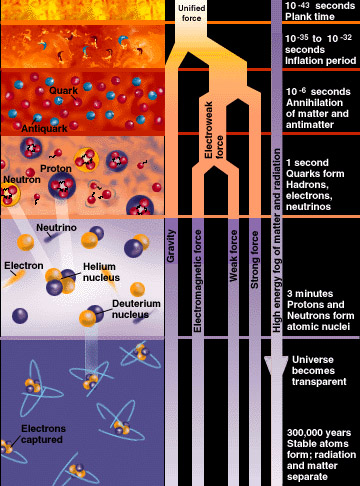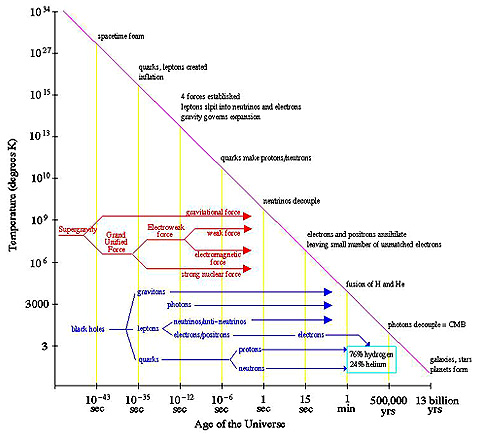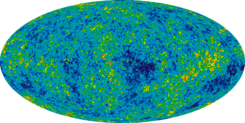
The separation of forces and evolution of matter following the Big Bang. Graphic by NASA, copied from Red Orbit - Big Bang
| The Primordial Era | ||
| Cosmos | The Early Universe |
| Cosmos home | ||||
| Sequence Back | Cosmic Timescale | The Stelliferous Era | Structure formation - Galaxies and Stars |
 The separation of forces and evolution of matter following the Big Bang. Graphic by NASA, copied from Red Orbit - Big Bang |
Editor's note: I'm just copying this from Wikipedia, as this is just a basic place holder page. I've also incorporated the Cosmology timeline from Niel Brandt's Timelines and Scales of Measurement Page (with original references). For another link, see Rob Knop's post on The History of the Universe at Galactic Interactions. In the future more text and links could be added here, if someone wants to contribute MAK110726
After cosmic inflation ends, the universe is filled with a quark-gluon plasma. From this point onwards the physics of the early universe is better understood, and less speculative. - Wikipedia
If supersymmetry is a property of our universe, then it must be broken at an energy that is no lower than 1 TeV, the electroweak symmetry scale. The masses of particles and their superpartners would then no longer be equal, which could explain why no superpartners of known particles have ever been observed. - Wikipedia
1 x 10-11 Electroweak unification spontaneous symmetry breaking Temperature: 3 x 1015 ( Kolb & Turner 1990 p.72)
Quark epoch: Between 10-12 seconds and 10-6 seconds after the Big Bang.
In electroweak symmetry breaking, at the end of the electroweak epoch, all the fundamental particles are believed to acquire a mass via the Higgs mechanism in which the Higgs boson acquires a vacuum expectation value. The fundamental interactions of gravitation, electromagnetism, the strong interaction and the weak interaction have now taken their present forms, but the temperature of the universe is still too high to allow quarks to bind together to form hadrons. - Wikipedia
2 x 10-7 Tauon anti-tauon annihilation Temperature: 2 x 1013 kelvin (Harrison, 1981, p. 353)
Hadron epoch: Between 10-6 seconds and 1 second after the Big Bang
The quark-gluon plasma that composes the universe cools until hadrons, including baryons such as protons and neutrons, can form. At approximately 1 second after the Big Bang neutrinos decouple and begin traveling freely through space. This cosmic neutrino background, while unlikely to ever be observed in detail, is analogous to the cosmic microwave background that was emitted much later. (See above regarding the quark-gluon plasma, under the String Theory epoch) - Wikipedia
1 x 10-5 Formation of hadrons from quarks Temperature: 2 x 1012 ( Kolb & Turner 1990 p.72)
7 x 10-5 Muon anti-muon annihilation Temperature: 1 x 1012 kelvin (Harrison, 1981, p. 353)
5 x 10-4 By this time the universe has a baryon-antibaryon asymmetry which results from post-inflationary B,C,CP violating processes Temperature: 4 x 1011 kelvin (Kolb & Turner 1990 pp.159, 281)
1 x 10-1 Neutral current weak interactions become too slow and neutrinos decouple Temperature: 3 x 1010 kelvin (Boesgaard & Steigman, 1985 p.322)
Lepton epoch: Between 1 second and 10 seconds after the Big Bang
The majority of hadrons and anti-hadrons annihilate each other at the end of the hadron epoch, leaving leptons and anti-leptons dominating the mass of the universe. Approximately 10 seconds after the Big Bang the temperature of the universe falls to the point at which new lepton/anti-lepton pairs are no longer created and most leptons and anti-leptons are eliminated in annihilation reactions, leaving a small residue of leptons. - Wikipedia
1 x 100 Charged current weak interactions become too slow and the neutron to proton ratio freezes out Temperature: 1 x 1010 kelvin (Boesgaard & Steigman, 1985 p.322)
1 x 101 Electron positron annihilation Temperature: 5 x 109 kelvin (Boesgaard & Steigman, 1985 p.322)
After most leptons and anti-leptons are annihilated at the end of the lepton epoch the energy of the universe is dominated by photons. These photons are still interacting frequently with charged protons, electrons and (eventually) nuclei, and continue to do so for the next 380,000 years. - Wikipedia
102 seconds Typical photon energies drop below the deuteron binding energy and nucleosynthesis begins. Temperature: 1 x 109 kelvin (Boesgaard & Steigman, 1985 p.322)
Nucleosynthesis: Between 3 minutes and 20 minutes after the Big Bang
 The abundances of the light elements due to Big-Bang nucleosynthesis. Graphic from What are the odds? Part 2: Cosmic Inflation! by Ethan Siegel |
103 Particle energies drop below Coulomb barrier energies and nucleosynthesis ends. Temperature: 4 x 108 kelvin (Boesgaard & Steigman, 1985 p.322)
During the photon epoch the temperature of the universe falls to the point where atomic nuclei can begin to form. Protons (hydrogen ions) and neutrons begin to combine into atomic nuclei in the process of nuclear fusion. These consisted only of the nuclei of the simplest chemical elements: mostly hydrogen and helium. However, nucleosynthesis only lasts for about seventeen minutes, after which time the temperature and density of the universe has fallen to the point where nuclear fusion cannot continue. At this time, there is about three times more hydrogen than helium-4 (by mass) and only trace quantities of other nuclei. - Wikipedia

Diagram showing the phylogeny of matter at the micro-level. From from The Evolutionary Eras after the First Minute, reproduced in turn from a website based on a course developed by Dr. J. Schombert of the University of Oregon, labeled 21st Century Science - The Birth of the Universe. See the above link for more detail. This diagram introduces the idea that Black Holes may have formed at the very moment of inception of matter, and were important in the formation of matter.
Matter domination: 50 to 70,000 years after the Big Bang. Up until this time, the expanding Universe is still relatively smooth and free of structure. At this time, the densities of non-relativistic matter (atomic nuclei) and relativistic radiation (photons) are equal. The Jeans length, which determines the smallest structures that can form (due to competition between gravitational attraction and pressure effects), begins to fall and perturbations, instead of being wiped out by free-streaming radiation, can begin to grow in amplitude. As a result, after 50,000 years or so mysterious dark matter clumps begin to collapse. According to ΛCDM, at this stage, cold dark matter dominates, paving the way for gravitational collapse to amplify the tiny inhomogeneities left by cosmic inflation, making dense regions denser and rarefied regions more rarefied. These are the structures that eventually lead to the birth of stars and galaxies, and eventually us. However, because present theories as to the nature of dark matter are inconclusive, there is as yet no consensus as to its origin at earlier times, as currently exist for baryonic matter. - Jodrell Bank wonder theme; Wikipedia
Recombination ca 377,000 years after the Big Bang - Cosmic microwave background radiation
 Observations by NASA's Cosmic Background Explorer and Wilkinson Anisotropy Microwave Probe revealed microwave light from the period immediately after the Big Bang, providing strong evidence for the Big Bang theory. Results from the Cosmic Background Explorer were honored with the 2006 Nobel Prize for Physics. (From Brief History of the Universe). WMAP data shows the microwave background radiation variations throughout the Universe from our perspective, though the actual variations are much smoother than the diagram suggests. (Wikipedia) |
Before decoupling occurs most of the photons in the universe are interacting with electrons and protons in the photon-baryon fluid. The universe is opaque or "foggy" as a result; light cannot travel far before it is scattered or absorbed. The baryonic matter in the universe consisted of ionized plasma. More precisely, ionized hydrogen and helium nuclei. That means that no electrons were bound to the nuclei, which (containing positively charged protons) are therefore electrically charged (+1 and +2 respectively).
At about 380,000 years after the Big Bang, temperatures have dropped to the point where the plasma has became neutral. The free electrons in the plasma are captured by the positive ions (nuclei), forming electrically neutral hydrogen and helium atoms, a process called recombination. This process is relatively fast, and faster for the helium than for the hydrogen. This releases the photons creating the cosmic microwave background radiation (CMB for short). Therefore, the photons can now travel freely (Compton scattering): the universe has become transparent. This cosmic event is usually referred to as decoupling. When the photons were released ( decoupled) the universe became transparent and light is free to travel unimpeded. At this point the only radiation emitted is the 21 cm spin line of neutral hydrogen. The temperature of the Universe when it became transparent was about 3,000 degrees. At this temperature the Universe would have glowed a dull red. At the end of recombination, most of the protons in the universe are bound up in neutral atoms. Because the photons present at the time of decoupling can now travel undisturbed (the average photons' flight path becomes effectively infinite), these are the same photons that we see in the cosmic microwave background radiation, after being further cooled and stretched into the microwave band of the electromagnetic spectrum by the expansion of the Universe. This is the faint hiss of radio waves found in whatever part of the sky radiotelescopes are pointed. They have been travelling across the Universe for almost 14 billion years. In this way, astronomy is rather like archaeology and paleontology. With the latter two, the more layers you dig through the farther into the past you look. With astronomy, the father out in space we look the farther back in time we see. The microwave background radiation provides a snapshot of the universe when it was only 380,000 years old; including the tiny fluctuations generated during inflation Jodrell Bank wonder theme; Wikipedia, Wikipedia
Dark ages: about 400 thousand to 100 million to a billion years after the Big Bang. Between Recombination and the appearance of the first stars and galaxies was a period when the universe was dark and the microwave background no longer traced the distribution of matter. It was during this fascinating but still little known period that the first stars and galaxies took shape. (See the Scientific American article The Dark Ages of the Universe by Abraham Loeb)
| The Very Early Universe | Structure formation - Galaxies and Stars |
content by Wikipedia. Edited RFVS111026
